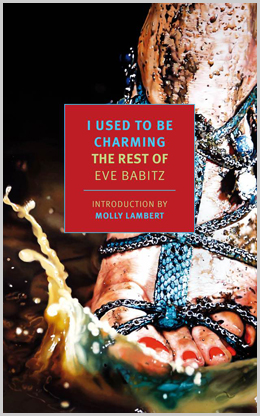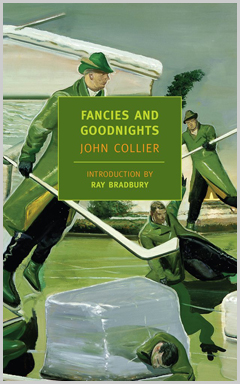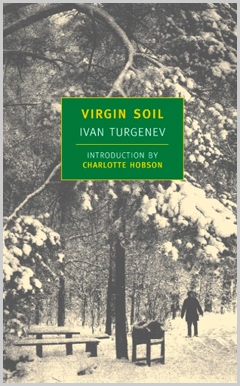Julie recommends I Used to Be Charming by Eve Babitz:
 I’ve read everything by Eve Babitz except for her nonfiction books Fiorucci, the Book; and Two by Two: Tango, Two-Step, and the L.A. Night, and only because the former costs an armload and the latter would have required making a purchase online (gross).
I’ve read everything by Eve Babitz except for her nonfiction books Fiorucci, the Book; and Two by Two: Tango, Two-Step, and the L.A. Night, and only because the former costs an armload and the latter would have required making a purchase online (gross).
I only mention this by way of saying that I’m not a binge reader of any author’s work (I need time for TV), but with Eve Babitz, it’s different. If she wrote the airplane flight safety guide, I’d read it. If she wrote the menu at The Cheesecake Factory, I’d gobble it down. If she scrawled a single word under a bridge, I’d brave my fear of murderers just to decipher the code.
When I told a fellow bookseller that if I had read Eve Babitz in my early twenties my life might have been very different, I wasn’t kidding. Perhaps I would have dropped out of college. Perhaps I would have bought a hotrod (a 1969 Pontiac GTO). Perhaps I would have ignored everyone who told me, “L.A. sucks, don’t move there.” Instead, I had to wait until my late thirties—a time when I’m officially going gray, a time when my idea of a wild night means renting DVDs from the public library—to finally find an author that I connect with, because if I know anything about reading Eve Babitz it’s that it’s very difficult not to become attached, or see her as a long-lost friend.
And pretty much everyone wants to be her friend (and/or ally). When Eve Babitz called into C-SPAN’s Book TV to say hello to Joan Didion, Didion smiled wide and said, “Hi Evie.” Eve didn’t ask her a “literary question”—she wanted to know about Didion’s fancy china and how she managed to put together such fabulous dinner parties with so many people passed out on the floor; it’s hilarious.
Eve Babitz dissolves the barrier between formal and informal, high art and low, celebrity hunk and average Joe; she writes books you can be yourself in the midst of—and you can bet money that my copy of Black Swans contains cookie crumbs and chocolate ice-cream stains.
It’s true, I have a bad habit of talking about the authors that I love like I hang out with them in my head, and I do. This means that I fail, as a reviewer, to speak cogently about the actual book. I neglect to talk about craft and voice and sentences, so here’s my one-line summation of Eve Babitz’s prose:
It’s great!
Nouns, verbs, and the other stuff, it’s all there and it works. I have so many favorite essays in I Used to Be Charming, it’s impossible to pick; they all reach out, whisper in your ear, and make you feel like you’re in on a daring heist—these are the sort of essays that’ll make you forget to put on your seatbelt.
In “My Life in a 36DD Bra, or, The All-American Obsession,” the essay begins in her quintessential deadpan style:
When I was fifteen years old, I bought and filled my first 36DD bra. Since then, no man has ever made a serious pass at me without assuring me in the first hour that he was a leg man.
In another piece, “Great Legs,” Babitz proves that two can play at the objectification game. Calling herself an “appreciative student of men’s legs,” she outlines all of the preferred types in ascending order:
There are, it seems to me, three basic styles of great [legs]: cowboy, athletic, and my beloved scrawny rock and roll. The cowboy legs most women can’t help feeling weak in the knees about are Clint Eastwood’s in those Sergio Leone movies. They are so graceful and divine that even my grandmother, dozing before the TV, sits up the minute the flute solo comes on.
I get her point, but I’m more of a butt gal.
In choosing Molly Lambert to do the introduction, NYRB made a good call. Lambert doesn’t attempt to close read in that way that twists your brain into a knot, nor does she fan-girl in that way that sucks all the fun out. She tells it straight about the city Eve adores: “Anyone who thinks Los Angeles is only gorgeous would-be starlets dangling over the maw of destruction has never had jury duty here.”
Like Babitz, Lambert is a true-blue Angeleno, aware of the hustle of being a writer in a city that’s shifting like a rubik’s cube. She writes:
The cost of living in L.A. has gone up absurdly…even as wages have stagnated, leading to a housing crisis that has pushed thousands of people into tent villages all over the city.
Loving a city doesn’t mean overlooking its flaws and injustices, nor does it mean ignoring how hard it is sometimes to survive. In the title essay Babitz writes:
I once read in The Village Voice that an artist was anyone over twenty-five without health insurance—well, that was me alright: over fifty without health insurance.
I finished the book with a feeling of deep gratitude that Eve Babitz exists. She produced a body of work—many pieces appearing in “women’s” magazines like Ms., Vogue, Cosmopolitan, and Self—in a voice so distinctive, writers today have to envy her and an era when editors didn’t squash out personality in favor of a uniform (snooze-fest) house style. In short, Eve Babitz can only write like Eve Babtiz.
Lambert gets it right when she states that:
To be a female artist is to put your own stubborn obsessions above all else in a world that still expects you to take care of other people while setting your own obsessive interests aside.
She reminds us that “Eve Babitz was of the first generation of women who really had it in their power to decide not to get married or have children.”
I always thought you had to be a sexless schoolmarm in order to become a great writer, but Eve Babitz disproves this. Foot-shuffling aside, I arrive at the point where I state the obvious, I Used to Be Charming is not a Babitz book one can live without, or you could, but it wouldn’t be fun.
* In true Hollywood style, I would like to thank everyone who made this review possible. To Joe Bratcher and Becky Garcia, for giving me a job. To Tracey, for keeping an eye on my tenses. To NYRB, for sending us cool stuff. To my mom, for letting me bake for nine months. And lastly, to Eve Babitz for not dying from smoke inhalation or over boogie.
 Fancies and Goodnights by John Collier
Fancies and Goodnights by John Collier

 Have you heard the story of the bog bodies, dear reader? It begins long ago and far away, and is the kind of tale you might want to read in the dark of the year, when the nights (even in Austin) are getting cold, and the days are shorter and shorter. It begins like this:
Have you heard the story of the bog bodies, dear reader? It begins long ago and far away, and is the kind of tale you might want to read in the dark of the year, when the nights (even in Austin) are getting cold, and the days are shorter and shorter. It begins like this: I’ve read everything by Eve Babitz except for her nonfiction books Fiorucci, the Book; and Two by Two: Tango, Two-Step, and the L.A. Night, and only because the former costs an armload and the latter would have required making a purchase online (gross).
I’ve read everything by Eve Babitz except for her nonfiction books Fiorucci, the Book; and Two by Two: Tango, Two-Step, and the L.A. Night, and only because the former costs an armload and the latter would have required making a purchase online (gross). In the Heart of the Heart of the Country
In the Heart of the Heart of the Country It only takes a few pages for this book to bewilder you. The Corner that Held Them begins with Alianor de Retteville, a twelfth-century English noblewoman who is not, by any means, the novel’s heroine. Nevertheless, it is she who will set the events that follow in motion. She is, at the beginning, in bed with her adulterous lover, she is surprised by her husband, she watches as her lover is killed, she is spared, she grows old, she has children, she dies. All this occurs in the first six pages, and the procession of events is so shocking that I hesitate to even describe it. Here, look:
It only takes a few pages for this book to bewilder you. The Corner that Held Them begins with Alianor de Retteville, a twelfth-century English noblewoman who is not, by any means, the novel’s heroine. Nevertheless, it is she who will set the events that follow in motion. She is, at the beginning, in bed with her adulterous lover, she is surprised by her husband, she watches as her lover is killed, she is spared, she grows old, she has children, she dies. All this occurs in the first six pages, and the procession of events is so shocking that I hesitate to even describe it. Here, look: